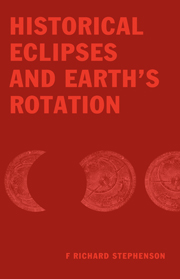Book contents
- Frontmatter
- Contents
- Principal Symbols
- 1 Variations in the length of the day: a historical perspective
- 2 Tidal friction and the ephemerides of the Sun and Moon
- 3 Pre-telescopic eclipse observations and their analysis
- 4 Babylonian and Assyrian records of eclipses
- 5 Investigation of Babylonian observations of solar eclipses
- 6 Timed Babylonian lunar eclipses
- 7 Untimed Babylonian observations of lunar eclipses: horizon phenomena
- 8 Chinese and other East Asian observations of large solar eclipses
- 9 Other East Asian observations of solar and lunar eclipses
- 10 Records of eclipses in ancient European history
- 11 Eclipse records from medieval Europe
- 12 Solar and lunar eclipses recorded in medieval Arab chronicles
- 13 Observations of eclipses by medieval Arab astronomers
- 14 Determination of changes in the length of the day
- Appendix A Timed data
- Appendix B Untimed data
- References
- Acknowledgements
- Index of eclipse records
- Index of places of observation
- Name Index
- Subject index
14 - Determination of changes in the length of the day
Published online by Cambridge University Press: 13 November 2009
- Frontmatter
- Contents
- Principal Symbols
- 1 Variations in the length of the day: a historical perspective
- 2 Tidal friction and the ephemerides of the Sun and Moon
- 3 Pre-telescopic eclipse observations and their analysis
- 4 Babylonian and Assyrian records of eclipses
- 5 Investigation of Babylonian observations of solar eclipses
- 6 Timed Babylonian lunar eclipses
- 7 Untimed Babylonian observations of lunar eclipses: horizon phenomena
- 8 Chinese and other East Asian observations of large solar eclipses
- 9 Other East Asian observations of solar and lunar eclipses
- 10 Records of eclipses in ancient European history
- 11 Eclipse records from medieval Europe
- 12 Solar and lunar eclipses recorded in medieval Arab chronicles
- 13 Observations of eclipses by medieval Arab astronomers
- 14 Determination of changes in the length of the day
- Appendix A Timed data
- Appendix B Untimed data
- References
- Acknowledgements
- Index of eclipse records
- Index of places of observation
- Name Index
- Subject index
Summary
Introduction
In chapters 4–13, more than 400 timed and untimed observations of both solar and lunar eclipses from the pre-telescopic period (date range –700 to +1600) have been investigated in detail. ΔT values or limits (depending on whether the observations were timed or untimed) have been derived in almost every case. The fundamental objective of the present chapter is to use these results to obtain the best-fitting ΔT curve to the data and hence to determine changes in the length of the day (LOD) over the historical period. In addition, the various geophysical mechanisms responsible for the observed variations will also be discussed. I am grateful to Dr L. V. Morrison of the Royal Greenwich Observatory for undertaking the data analysis which forms the basis of much of this chapter and producing several of the diagrams. This chapter is essentially an enlargement of section 5 of the paper by Stephenson and Morrison (1995). Although several tens of further historical data have been added (notably medieval Chinese timing – see chapter 9), the basic conclusions obtained in that paper remain unchanged.
All of the ΔT results derived in chapters 4–13 are summarised in tabular form in the Appendices for ready reference. For each individual observation, only the year (– or +) and appropriate ΔT value or limits are tabulated. Appendix A contains timed data and Appendix B untimed material, each being divided into sub-groups depending on the source and type of observation it contains.
- Type
- Chapter
- Information
- Historical Eclipses and Earth's Rotation , pp. 501 - 517Publisher: Cambridge University PressPrint publication year: 1997



